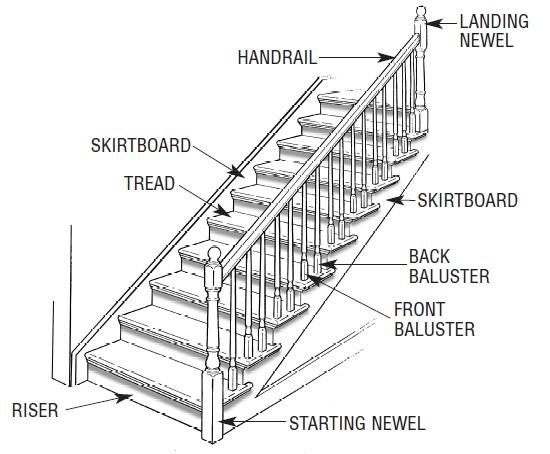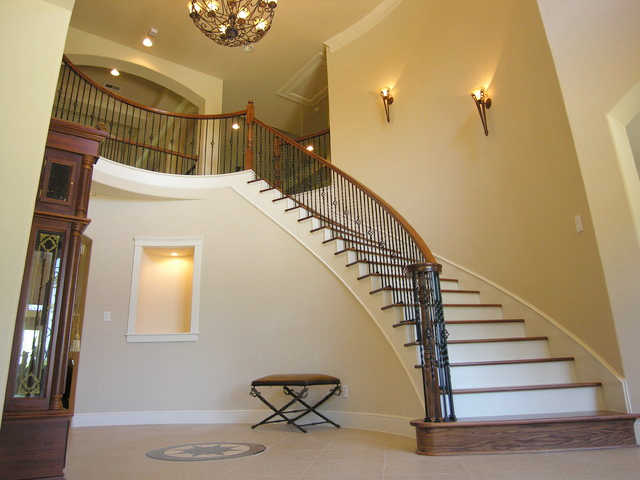Let's talk about your staircase. Staircases are something that are so much a part of our homes that we take for granted. They're there, most of us use them every day, but we don't really know "what makes 'em work."
There are a surprising number of components to a staircase. Here are some of the most used parts, the name they are known by, and what role they play in the whole:
Baluster- the vertical post that fits between the handrail and either the tread or the base rails
Balustrade- The whole baluster and rail system
Cove Molding-The decorative strip that is attached under the stairnosing, which covers the joint between the riser and the tread
Handrail- the horizontal piece of the balustrade system, sits on top of the balusters and is supported by newel posts
Newel- The major support post for the balustrade system, located at the bottom and top of the staircase, and at turns and critical support areas
Nosing- the edge of the tread that projects beyond the adjoining riser
Riser- The board that forms the vertical part of each step
Rosette- The round or oblong piece that attaches the handrail to the wall
 Skirtboard- the usually decorative trim piece that fits along either side of the stairs along the wall, or the "baseboard" of the staircase
Skirtboard- the usually decorative trim piece that fits along either side of the stairs along the wall, or the "baseboard" of the staircase
Stringer- the framework upon which the stair structure rests, usually two pieces
Tread- the horizontal portion of each step, the part that is walked on
And here's the bonus stair trivia- that space under the stairs (where most of us have a coat closet) actually has a name! It is the spandrel.
Stairs are functional, that is why they exist. Yet since most stairs are at or near our front door (sometimes the first thing one sees when they walk in), we need for them to be pretty. Stairs can be carpeted, wood, or a combination of these- stained wood with a runner.


There are a couple of good reasons to have carpet or a runner on the stairs. First, especially if you have children in the house, having the stairs covered will cut back on the noise. Nothing says teenage boy like the noise they make thundering up or down the stairs. And while wood stairs are beautiful, we feel that a covering of some sort makes them safer as well. For dogs, for children, and especially for older adults, a slip on the stairs can be tragic. A runner is a nice compromise that is safe and beautiful. Runners can be made from any carpet that we sell here in the store. Some of our patterned carpets make especially great looking runners. As a rule of thumb, a runner should cover 80 to 90% of the stair tread. Runners made from carpet can be serged or bound. Serged is somewhat like a blanket stitch, sewed around the cut edge. Bound means a piece of material (usually fabric) is sewn on to the carpet forming a new finished edge.

We do also carry an extensive selection of premade runners
from Karastan and from Stanton. They are all beautiful and easy to care for, while making a real decorating statement in your home. Some are traditional, but there is a good selection for more contemporary tastes as well.
As well as runners, we also carry a huge assortment of choices for new balusters and handrails, from simple and traditional, to much more detailed and "out there." wood, which can be painted or stained, or wrought iron, available in many finishes.
Consider coming to the store and let us show you how we can completely change the look of your staircase. We can sand and stain the treads, replace your balusters, newels, and handrails, and create a beautiful new runner for you! And appreciate your stairs- they work for you every day!
Don't forget about the lighting. The most beautifully designed staircase will not be noticed and is not safe when there is poor lighting. Many staircases are located in the center of the home, away from main windows. And if you have a back staircase and/or a staircase to your basement, chances are it has no natural lighting whatsoever. Use artificial lighting to turn your staircase into even more of a feature and choose chandeliers and other light fixtures that offer enhanced visibility on your staircase.

A typical staircase with new treads and risers will cost around $2100. A staircase (13 steps) with all new balusters will average between $1300 and $1800. A staircase TOTALLY redone (new treads and risers, new balusters, handrails, and newel posts-not including new carpet) usually costs around $5000--$8000. Adding a carpet runner will range between $600 and $2000, depending upon the cost of the carpet chosen and the details of the installation.
I Was FLOORED By Enhance
Jenny in Canton writes "Enhance Floors did incredible work. They were very courteous and kind, and they were very thorough. I think they did an excellent job. They put in wood floors and a new staircase. They're tremendous, easygoing people. I've already recommended them to others."



Super Flat Flooring
ReplyDelete